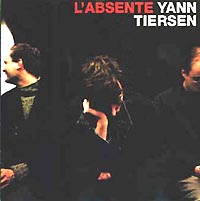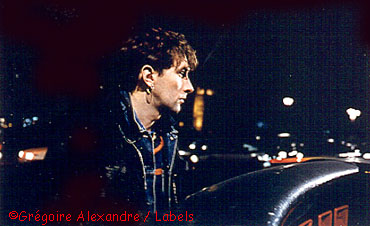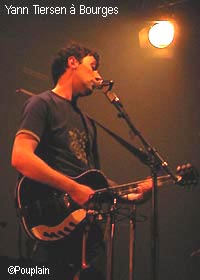Album review
Yann Tiersen
Absente, but more present than ever at Bourges
Bourges
23/04/2001 -
 Yann Tiersen blew into a press conference at Bourges earlier this week with the force of a mini tornado. Throwing himself onto a chair and flinging his packet of cigarettes on the table, Tiersen followed this blustery performance with total silence. Tiersen's stony-faced silence could have been interpreted as arrogance or a bad mood, but as anyone who has followed his career will know, the musician has trouble overcoming his natural timidity off stage – especially when confronted with a room full of hardened music journos!
Tiersen is not a man given to explaining his lyrics or expounding on his musical inspiration. But his natural charm and sincerity melted the press-conference ice and a free-flowing dialogue was soon taking place between musician and journalists. This has been the rhythm of Tiersen's career all along. When he started out on the local Rennes music scene his compositions tended to be short, minimalist and reserved, but in recent months Tiersen's work has entered a more confident, flamboyant phase and these days the composer/multi-instrumentalist expresses himself through longer, more complex pieces.
This is very much the case with the twelve tracks on Tiersen's new album – all written by himself apart from Bagatelle and Les Jours tristes, the former written by Dominique A, the latter by British singer Neil Hannon (who both sing vocals on their own contributions). L'Absente features a host of other guest vocalists too, many of whom will already be familiar to Tiersen fans. Speaking about his new album at the Bourges press conference, Tiersen insisted that vocals form an essential part of his work. "Everything stems from the song itself," Tiersen explained,"I spend a lot of time thinking about how I want a particular song to sound and then I invite the right person along to record it. I suppose you could say it's a matter of the right energies coming together at the right moment."
Dominique A and Neil Hannon are joined on Tiersen's new album by an impressive list of vocalists including American singer Lisa Germano who gives an excellent performance on la Parade, le Méridien. Young French actress Natacha Régnier, who starred in Erick Zonca's award-winning film La Vie rêve des Anges also puts in an appearance on L'Absente - which is appropriate when you think about it, as Tiersen's classic la Rue des cascades played such an essential role on Zonca's film soundtrack. Régnier's half-sung, half-spoken vocals are used to dramatic effect on l’Echec and le Concert where they appear alongside Tiersen's own voice.
Yann Tiersen blew into a press conference at Bourges earlier this week with the force of a mini tornado. Throwing himself onto a chair and flinging his packet of cigarettes on the table, Tiersen followed this blustery performance with total silence. Tiersen's stony-faced silence could have been interpreted as arrogance or a bad mood, but as anyone who has followed his career will know, the musician has trouble overcoming his natural timidity off stage – especially when confronted with a room full of hardened music journos!
Tiersen is not a man given to explaining his lyrics or expounding on his musical inspiration. But his natural charm and sincerity melted the press-conference ice and a free-flowing dialogue was soon taking place between musician and journalists. This has been the rhythm of Tiersen's career all along. When he started out on the local Rennes music scene his compositions tended to be short, minimalist and reserved, but in recent months Tiersen's work has entered a more confident, flamboyant phase and these days the composer/multi-instrumentalist expresses himself through longer, more complex pieces.
This is very much the case with the twelve tracks on Tiersen's new album – all written by himself apart from Bagatelle and Les Jours tristes, the former written by Dominique A, the latter by British singer Neil Hannon (who both sing vocals on their own contributions). L'Absente features a host of other guest vocalists too, many of whom will already be familiar to Tiersen fans. Speaking about his new album at the Bourges press conference, Tiersen insisted that vocals form an essential part of his work. "Everything stems from the song itself," Tiersen explained,"I spend a lot of time thinking about how I want a particular song to sound and then I invite the right person along to record it. I suppose you could say it's a matter of the right energies coming together at the right moment."
Dominique A and Neil Hannon are joined on Tiersen's new album by an impressive list of vocalists including American singer Lisa Germano who gives an excellent performance on la Parade, le Méridien. Young French actress Natacha Régnier, who starred in Erick Zonca's award-winning film La Vie rêve des Anges also puts in an appearance on L'Absente - which is appropriate when you think about it, as Tiersen's classic la Rue des cascades played such an essential role on Zonca's film soundtrack. Régnier's half-sung, half-spoken vocals are used to dramatic effect on l’Echec and le Concert where they appear alongside Tiersen's own voice. 
Apart from this rare interlude Tiersen's voice barely features on the rest of the album at all. "I've always had a real block about my own voice," Tiersen admits, "I used to listen to the stuff I did with groups when I was younger and think my voice sounded really shit. But gradually I came round to the idea of writing songs in French and realised I didn't want them sung by other people. So I started singing them myself – in fact, I really enjoy singing my own songs now!" Songwriting is an organic whole in the Tiersen universe. "When I sit down to write,"Tiersen explains, "I don't do the arrangements and the melody separately. Everything comes out at once. So right from the word go I know if I want to sing the song myself or invite someone else into the studio to do it for me. On songs where the melodies are more elaborate I tend to get other people involved because I don't think I've got the necessary vocal skills!" L'Absente also features noteworthy contributions from several of Tiersen's musician friends including Christian Quermalet from Married Monk and 43 musicians from the Synaxis Orchestra (based in the Rhone Valley). It goes without saying that Tiersen's old mates Les Têtes Raides also feature prominently on his new album. The group co-wrote two songs with Tiersen, le Jour d’avant and la Lettre d’explication on which a clickety-clackety typewriter stars as percussive accompaniment. But then this is precisely what you'd expect from an innovative multi-instrumentalist like Tiersen! "I don't know how many different instruments I play,", Tiersen mumbles modestly, "I've never really counted! Numbers are not important to me. It's the physical rapport I have with an instrument that counts. When I get the urge to hear a certain sound I'll pick up anything that comes to hand – whether I know how to play it or not! I like working like that. It gives my music a certain naïve edge. I love playing instruments like the toy piano, for instance, because it takes me back to my childhood. I'm always curious to experiment with new instruments and find out what they sound like!" L'Absente contains its fair share of haunting instrumental tracks where Tiersen bursts into virtuoso solos on piano or violin. (Qu’en reste-t-il ? is a prime example of Tiersen at his instrumental best). While these instrumental interludes are always charged with atmosphere and emotion, Tiersen's reputation for moody nostalgia is ill-deserved. "I really don't like the word nostalgia," Tiersen insists, "I'm not into looking back to the past all the time. I'd say I'm someone who's much more nostalgic about the present. I tend to hang onto the present moment because I'm scared I'll end up losing what I've got today!"
 Interestingly enough, the cover of Tiersen's new album features a photo of the musician asleep on the London underground. But don't go looking for any hidden meanings in the choice of cover photo! "I was completely worn out from working in the studio at the time," Tiersen explains.
In fact, the French musician chose to mix his new album in Brixton, a happening area of London that has always been associated with musical anarchism and militant rock. In fact, it's no coincidence that 70s punk band The Clash (one of Tiersen's earliest musical influences) fuelled their rage and their anarchic guitar sound here. "I could have recorded the album in a much chic-er area of London," Tiersen says, "But I happened to be there. I don't want people to go reading lots of symbolic meanings into this though. Brixton made an impact on me, that's all, so I wanted it to feature in the CD booklet somewhere!"Atmospheric shots of London feature prominently in the CD booklet to L'Absente. But Tiersen had no need of any photographic aids when it came to creating an atmosphere on stage at Bourges on Wednesday night. Playing to an audience of committed fans, Tiersen brought the house down as soon as he strode on stage and positioned himself in the middle of a strange array of instruments and a troupe of ten musicians (including guest vocalists Claire Pichet and Natacha Régnier).
Interestingly enough, the cover of Tiersen's new album features a photo of the musician asleep on the London underground. But don't go looking for any hidden meanings in the choice of cover photo! "I was completely worn out from working in the studio at the time," Tiersen explains.
In fact, the French musician chose to mix his new album in Brixton, a happening area of London that has always been associated with musical anarchism and militant rock. In fact, it's no coincidence that 70s punk band The Clash (one of Tiersen's earliest musical influences) fuelled their rage and their anarchic guitar sound here. "I could have recorded the album in a much chic-er area of London," Tiersen says, "But I happened to be there. I don't want people to go reading lots of symbolic meanings into this though. Brixton made an impact on me, that's all, so I wanted it to feature in the CD booklet somewhere!"Atmospheric shots of London feature prominently in the CD booklet to L'Absente. But Tiersen had no need of any photographic aids when it came to creating an atmosphere on stage at Bourges on Wednesday night. Playing to an audience of committed fans, Tiersen brought the house down as soon as he strode on stage and positioned himself in the middle of a strange array of instruments and a troupe of ten musicians (including guest vocalists Claire Pichet and Natacha Régnier).
Tiersen received expert accompaniment from a string quartet (which included William Sheller's violinist and cellist) as he worked his way through an impressive selection of instruments, his fingers flying across toy piano, guitar, violin, accordion and the "Martenot", a bizarre-looking electronic keyboard dating back to 1928. The size of Tiersen's Bourges venue (which boasted an audience capacity of 2,400) meant the musician's delicate repertoire got lost in the vastness every now and then. But, looking very much at ease in the role of conductor and on-stage orchestrator, Tiersen powered his way through his new repertoire, proving that both he and his music have come a long way since his reserved minimalist debut.
Catherine Pouplain - Pédron










